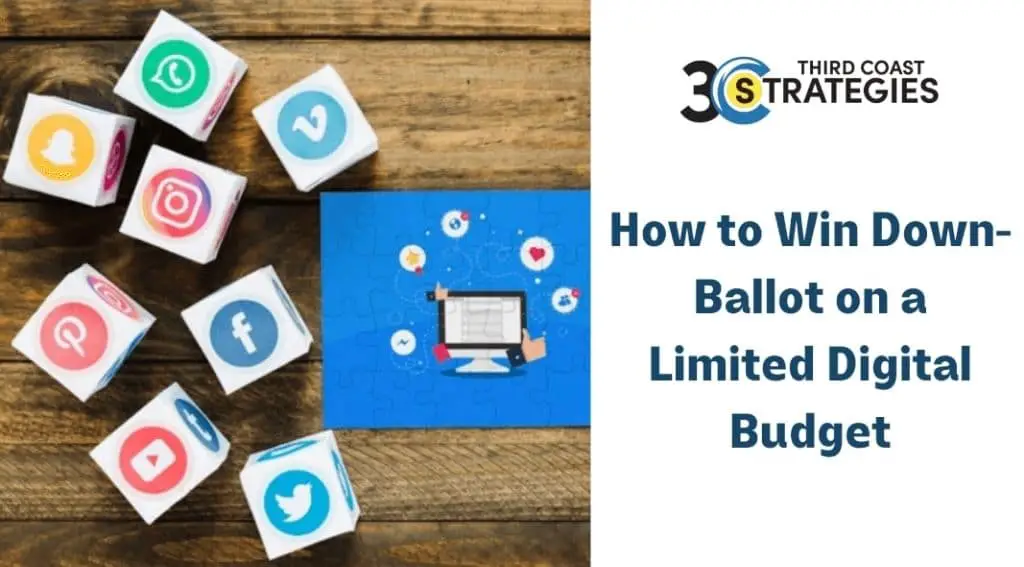How to Win Down-Ballot on a Limited Digital Budget

Digital programs can be powerful campaign assets when they are executed properly. Unfortunately, ballot campaign committees are typically understaffed, underfunded, and overconfident. This guide aims to help the latter group of committees by strategically allocating limited resources to digital media.
We’ve all heard about top-of-the-ballot campaigns that win with a single tweet or Facebook post. That’s great for them, but that strategy won’t work for every campaign because not every campaign consultants has the same resources to commit to digital outreach.
Down-ballot campaigns have a few additional challenges
- Smaller budgets
- More local and specialized media
- Less name recognition
But they still face the same overall problem of how to reach their voters before Election Day without breaking the bank or running on empty.
The amazing news is that with a few tweaks, digital strategies can work wonders for these races, too — you just need to think outside the box.
Because of the nature of down-ballot races (and the small budgets that go along with them), it can be tough to bring in voters through digital ads or organic social media posts. Maintaining name recognition is even more difficult for lower offices since not everyone pays attention to political campaign strategies on a local level.
And just because your down-ballot race doesn’t have a big budget, that doesn’t mean you can ignore digital strategies entirely — it just means you have to get creative.
Tips to win down-ballot on a restricted digital budget
What do you need to do if you’re on a limited budget and trying to get your message out there? Here are some tips:
-
Prioritize platforms that best match your voter universe
The platform you choose should align with your voters’ time online. If you want to reach Hispanic voters, prioritize Facebook. If you are looking to reach fiscally conservative retired veterans, then you’ll probably find the most success reaching them on LinkedIn.
-
Know your audience
This one should be obvious, but it’s important enough that we’ll repeat it: know your audience! Really get in there and research them. While targeting specific demographics in a campaign field organizer is important, you should also consider their interests and behaviors.
-
Use your paid media budget wisely
If you’re running a ballot question campaign, then the money spent on digital advertising will be recouped. Through earned media, voters are searching online for information that they expect to find for free. However, if you’re running a candidate campaign, you’ll likely be able to win votes by responding on the platforms where your audience spends its time.
-
Use earned media as a stand-in for digital advertising
If you don’t have enough budget for paid ads, then some great earned media opportunities can help establish your brand and build an audience for future digital outreach.
-
Go where the people are, not where you think they are!
Digital platforms change quickly. Just because your campaign won big on Twitter in 2012 doesn’t mean that it will translate to success now; even Facebook has changed dramatically over the last few years with algorithm changes and new features like newsfeed ads.
-
Have a plan
Digital outreach isn’t a “set it and forget it” strategy for political endorsement because technology changes constantly. If you’re trying to break through the noise, then you must have a team dedicated to monitoring your digital presence as well as those of your opponents. Someone needs to be there from day one until the campaign’s final day.
-
Budget for your future
Digital outreach costs money, but it will pay for itself in earned media and future supporters if you do it right. Make sure you have a budget for maintaining social media presences after Election Day so that you can continue to grow your audience and keep voters engaged with issue-based information.
-
GOTV
Campaigns are about getting your voters to the polls. This doesn’t change with digital outreach. You should still ensure that you’re engaging in GOTV efforts online just like you would on canvases, phone calls, and mail pieces. In addition to the typical “make a plan to vote” ads, you should also include ads specific to the election. It’s important to remind your voter base when the election is, where they vote, and what’s on the ballot.
-
Measure, measure, measure
The digital landscape constantly changes, so it’s essential to set goals before every outreach campaign and track the results afterward. For example, you should always be trying to maximize your budget or increase conversions by finding out which ads work and which don’t. Also, pay attention to the time of day, audience size, and engagement metrics. There are a lot of tools out there that let you test different variables.
-
Don’t be nervous to ask for help
If you’re not familiar with digital outreach, then don’t be afraid to reach out to someone who is! Many consultants specialize in the digital aspects of campaigns strategists, and they likely know your audience better than you do. Similarly, if you need more budget but can’t get it approved, then you should be able to find someone who can write an awesome proposal for you.
Conclusion
Digital strategies are vital in any campaign’s toolkit, but they’re especially vital for down-ballot races. Campaign consultants have to fight the perception that small races don’t matter – and it’s much easier to do this when you can deliver your message directly to your voters.
It doesn’t matter if you’ve never done digital outreach before, either. There are ample digital tools out there that can help even the least tech-savvy campaign, and you don’t need to spend a fortune on them either. All you have to carry out is properly utilize these tools, and you’ll see an immediate boost in engagement on all your social media channels.
